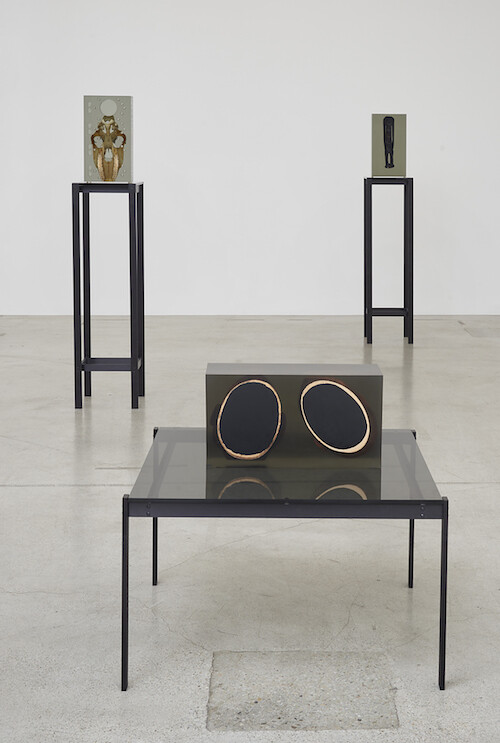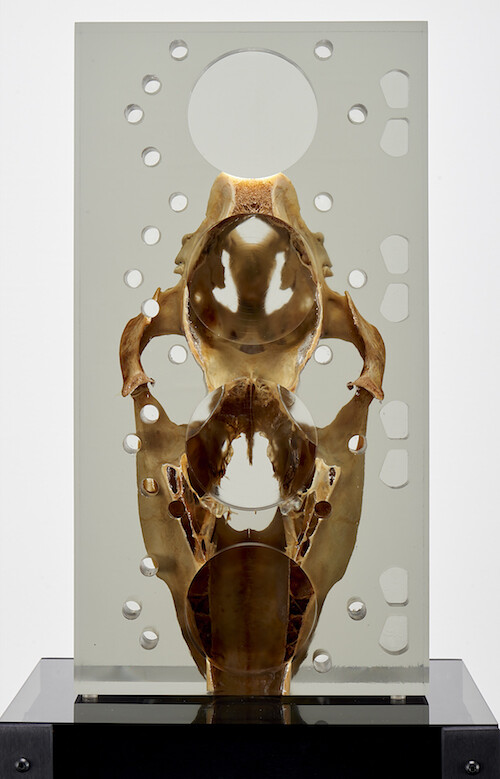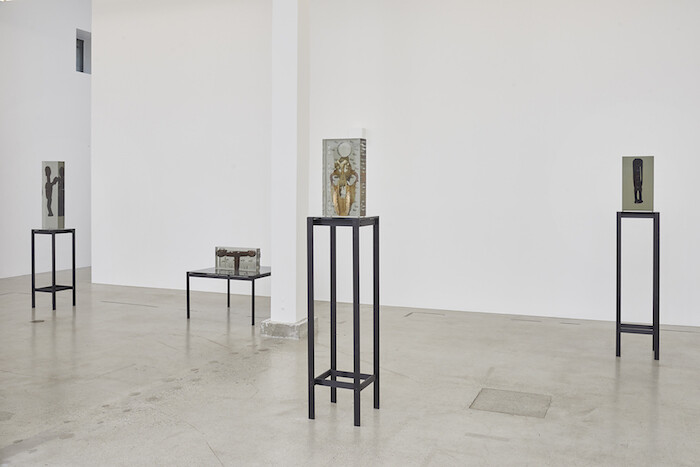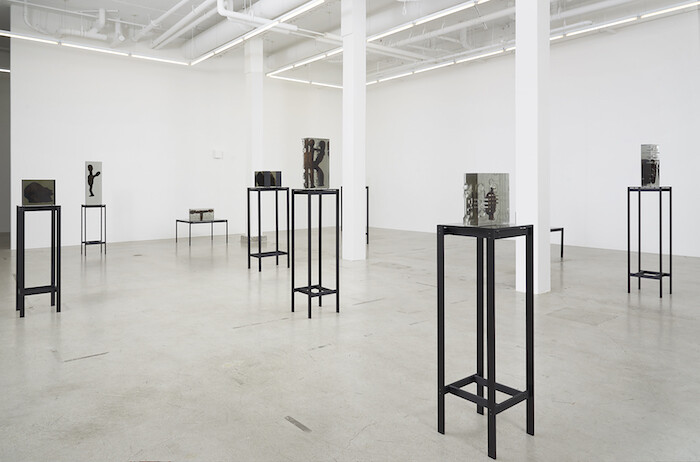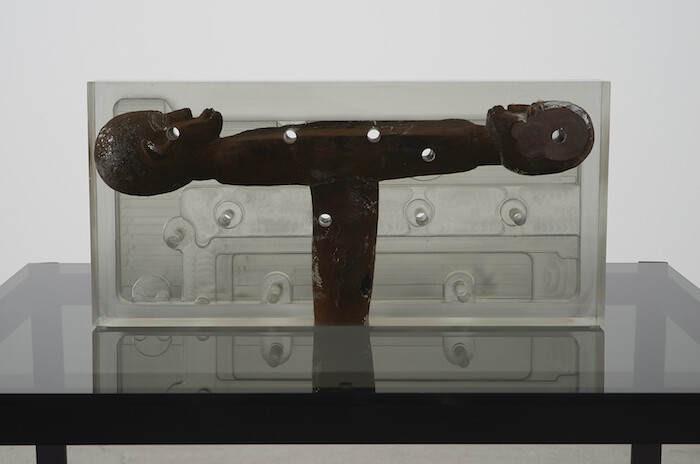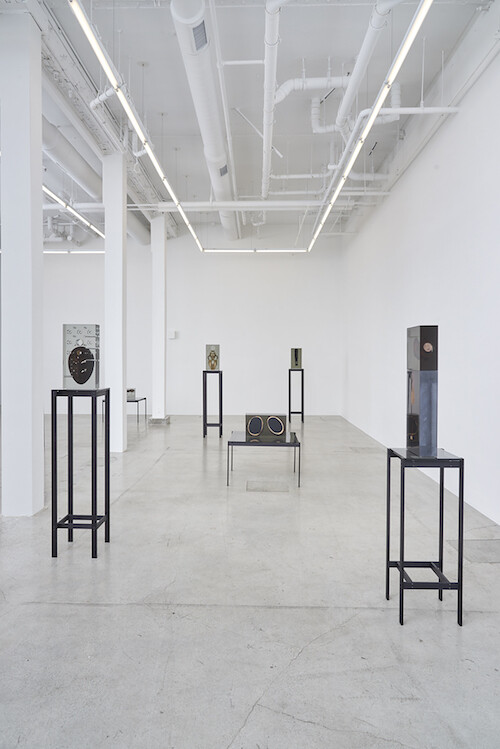In an early scene in the recent blockbuster hit Black Panther, the black supervillain Erik Killmonger disputes the narrative spewed to him by a supercilious white curator regarding an African artifact on view in the “Museum of Great Britain,” asserting instead that it is a spoil of war from the (fictitious) country Wakanda. Immediately following their verbal exchange, she drops dead from poisoned coffee, and he repossesses the pillaged object in an elaborate heist. This example from popular culture demonstrates that the need to address the complicity of western museums in colonialist narratives has reached beyond the confines of the art world. The complicated politics of museum display are one of several interconnected issues—including commodification and authenticity, the role of industry and labor in cultural production, and black identity—that Detroit-based Matthew Angelo Harrison addresses in his first solo commercial gallery exhibition.
Twelve sculptures of varying heights comprise “Prototypes of Dark Silhouettes” at Jessica Silverman Gallery. Mounted on minimalist pedestals made of anodized aluminum legs and acrylic tops, tinted resin blocks that evoke the translucent geometric forms of the Light and Space movement encase what appear to be African art objects. The figures, heads, and masks are visible through varying levels of opacity, modified by means of patterns carved into the surface of the resin. The press release notes that some of these found wooden sculptures come from the Makonde and Dogon peoples. However, purchased on eBay by the artist, their true origins are murky, emphasized by the literal lack of transparency in the surrounding resin. African artifacts—often generically associated with an entire continent and stripped of their time period—have long been treated as trendy home adornments, and the ritual objects on view here may very well be counterfeits. Authenticity in the age of mass production is elusive.
Allusions to industrial manufacturing abound throughout the exhibition, beginning with the title. Until recently, Harrison worked at Ford, creating models of vehicle prototypes. In Dark Silhouette: Zebra Manifold Composition no. 1 (2018), the symmetrical skull of a zebra is suspended in resin as though exposing the skeleton of the work. The word manifold, used in the title, references both the intake and the exhaust manifold of a car and the idea of literal and conceptual layers. For several of the works, Harrison used a CNC router that he built himself to carve patterns borrowed from the Ford factory into the resin blocks. In Dark Silhouette: Seated (2018), holes burrow all the way through the two-headed humanoid wooden sculpture within, creating a connection between this clichéd representation of a generalized African culture and the labor behind car manufacturing that is both direct and porous. This enigmatic form representing traditional African culture is only distantly linked to black Americans, whereas the industrial materials and factory-inspired pattern speak more directly to the history of African American cultural identity in the Detroit area (i.e. Ford was the largest employer of black workers in Detroit in the 1920s and ’30s).
Harrison’s impeccably designed sculptures, which fuse natural materials and machine-made elements, operate between the polemical work of an artist like Fred Wilson and the more abstract politics of someone like Liam Gillick. Unlike the directed critique of museological display in Wilson’s Spoils (1990)—which includes a row of six African masks each bound or gagged by a colonial flag—Harrison offers a willfully ambiguous inquiry into the display of these objects, addressing not only their anthropological and art-historical value but also challenging their relevance to contemporary identity. Like Gillick, Harrison uses industrial materials—aluminum and acrylic—to create formal designs that obliquely reference social systems and capitalist production.
In “Prototypes of Dark Silhouettes,” figurative African sculptures are bifurcated, punctured, turned on their side, and obscured in translucent blocks. The juxtaposition of these manipulated figures and the accompanying pedestals in the style of midcentury modernism evokes the tension between African exoticism and European design, and the resulting works complicate the viewers’ perception. By entangling these organic objects with industrial materials in formal explorations, Harrison suggests a lineage between traditional African wooden sculptures and the recent history of manufacturing in the United States, a trajectory tortuous and fraught.


